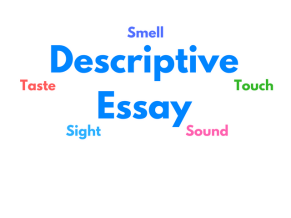
A descriptive essay is one that appeals to one of the five senses (touch, taste, sight, sound, smell) and uses details to provide the reader with a vivid idea or picture of what is being represented.
Your professors may ask you to write short, descriptive essays in some classes, but most often you’ll want to add a descriptive style to different types of essays. Narrative essays should generally be quite descriptive, for example. Still, you may encounter assignments in which you are asked to maintain a descriptive style for most of the essay. Here are some key ideas to keep in mind when writing a descriptive essay.
Strategies for Writing Your Descriptive Essay
Choose a Topic
Choose a topic you care about, something that evokes powerful emotions, but remember that sometimes being close to a topic can hamper your ability to describe it to others. Step back and imagine your topic from the perspective of someone who knows little about it. Your use of descriptive writing should invite readers to feel the same sensations you do when reading about your topic.
Of course, you want to know your topic well enough to write rich and vivid descriptions.
Do Some Prewriting
Freewrite about your topic to discover aspects you feel strongly about. Quickly write everything that comes to mind about your topic, and don't be afraid to follow threads that excite you.
From your freewriting exercise, you might start a list of potential points to talk about and quickly brainstorm any other points that come to mind. You will then have lots of material to choose from as your narrow your focus for the essay.
Consider Your Audience
Consider how much your audience knows about your topic? This can affect the focus of your descriptions. For example, you might focus on primary or popular aspects when writing to an audience unfamiliar with your topic, while focusing on more technical aspects when writing for an audience that knows your topic well.
Show, don't tell
Imagine that you’re painting a vivid picture with words. You don’t want to tell the reader what you witnessed. Instead, you want to provide the reader with enough details so that he or she will get as close to the experience as possible. For example, you may love to have popcorn while you watch movies. If you were only telling this to readers, you might say something like this:
I love the taste of popcorn while watching movies.
Showing would be more like this:
Buttery, fluffy kernels of salty fresh popcorn melt in my mouth as I stare at the movie screen, the characters in soft focus.
Let your words carry the load, and do not rely on exclamation points. Even if the situation you describe is very exciting or emotional, avoid exclamations like: "Wow!" "Dang!" "I marvel at its beauty!" or the like. And don't USE ALL CAPITALS to emphasize a point.
Decide How You Will Organize Your Essay
Three common ways to organize your descriptive essay are chronologically, spatially, or by the order of importance.
Chronological Arrangement
A chronological arrangement is useful if you are describing important memories or events.
Chronological organization structures your essay around the time and events associated with the place you are describing. This type of organizing method structures the images and sensory appeals around a chronological movement through time, usually focused on a particular event. To organize it this way, you might imagine yourself reliving a particular event that took place at this location — at each significant moment, what do you feel, hear, see, remember?
Spatial Arrangement
A spatial arrangement is useful if you are describing a place or physical object.
Spatial organization involves organizing your essay around the physical structure of the place you are describing. This type of organizing method structures the images and sensory appeals around the objects and physical features of the space. To organize it this way, you might imagine yourself moving through the space you are describing — at each significant point what do you feel, hear, see, remember?
Order of Importance
This method organizes the details of your description according to importance; what is the most prominent feature of the place that you are describing, and what is the least prominent? This type of organizing method structures the imagery and sensory appeals around the physical features or memories of a place, but instead of spatially or chronologically, orders them from most to least important, or vice versa. You might also employ a mix, where important elements are placed at the beginning of the essay to grab readers' attention, lesser but interesting elements placed in the middle, and perhaps the most important elements placed at the end to create a strong finish.
Summary
Knowing how to write with a descriptive style is going to help you with many essay types in many disciplines. Being able to add details that appeal to the 5 senses of your readers and being able to show your readers, instead of just telling them something, will make you a stronger writer.
License and Attribution
